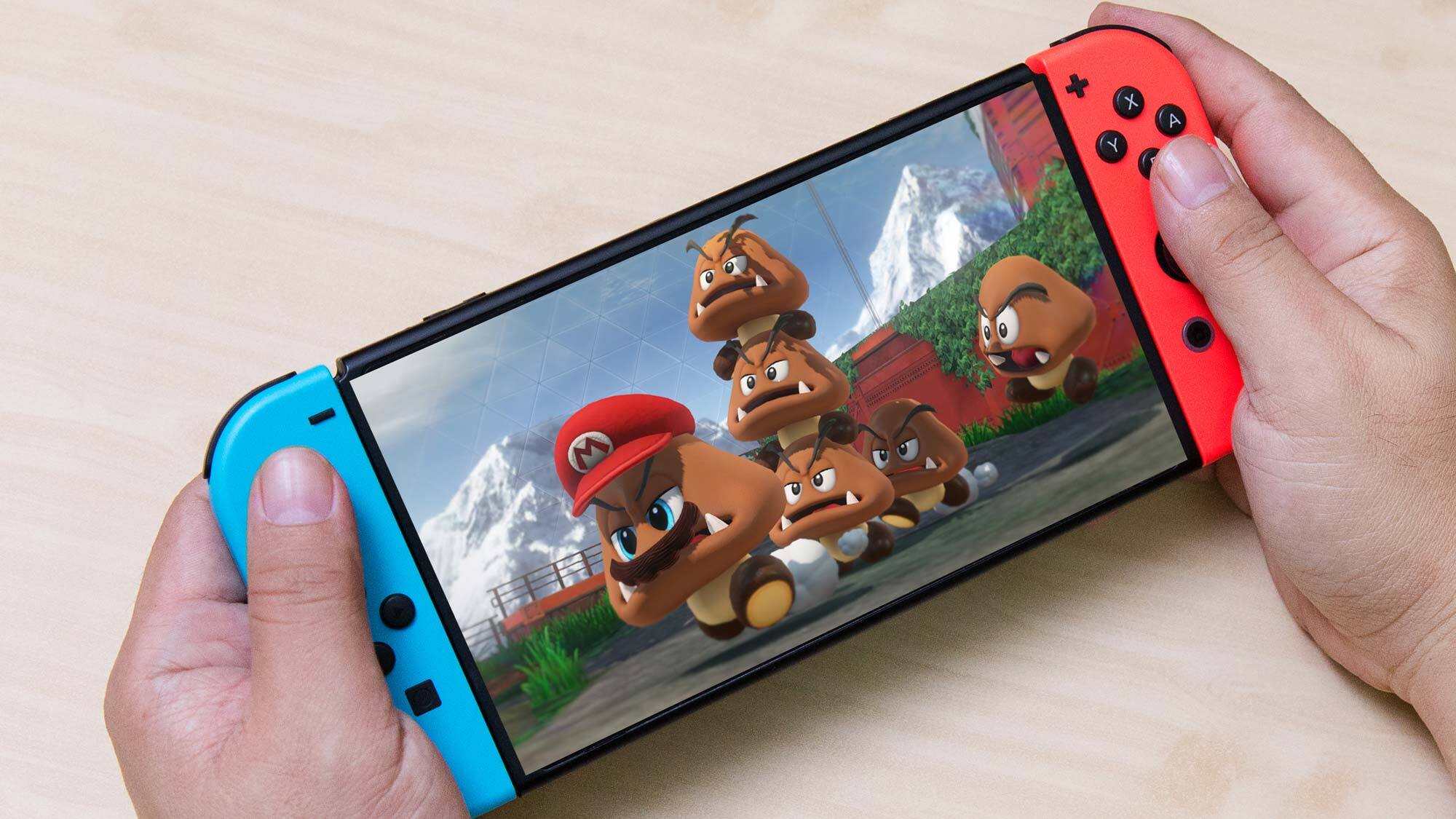
Earlier this week Bloomberg reported that a possible Nintendo Switch Pro is in development, with Samsung Display being sourced to provide OLED panels for the upcoming console-portable hybrid. But in speaking with analysts at Display Supply Chain Consultants (DSCC), an industry consultancy firm based in Austin, TX, more finite details about a new Switch have been exclusively revealed to Tom’s Guide.
Fans looking to upgrade their aging Nintendo Switch units should expect a handheld with a slightly larger display, going from 6.2-inches to 6.99-inches, better battery life and a September launch at the earliest.
- These are the best Nintendo Switch games worth buying
- Where to buy Nintendo Switch Monster Hunter Rise Edition
- Plus: Nintendo Switch Pro with OLED display revealed — it could launch this year
Mirroring Bloomberg’s report, DSCC was able to confirm that Nintendo has ordered 6.99-inch displays with resolution at 1280 x 720. Nintendo is also ordering 500,000 to one-million units per month, DSCC says. By securing an order with Samsung now, Nintendo can produce enough units to hopefully satiate holiday demand later this year.
“If they're making the products from June — we're hearing they're going to start shipping in July, that even a September launch should be possible,” said Ross Young, co-founder and CEO of Display Supply Chain Consultants. “Given the time lag from panel shipment to device production, and then device production to retail, it could be September, October.”
Fans should also expect better battery life with the new Nintendo Switch Pro. Coupled with the power advantages found in OLED, the thinner display should also mean more room for Nintendo to add a slightly larger battery. Together, this could mean upwards of a 20% improvement in overall battery life, bringing the new Switch to a little more than five hours when playing graphically intensive games. But with OLED, the type of game being played makes a difference.
“LCDs use a maximum brightness, whether it's a white or black image. And OLEDs don't,” said Young. “Their power consumption varies with the content. So it's going to depend on the type of content that you're playing. If it's video, OLEDs have a big advantage. But if it's a bright video game with a lot of white, then OLEDs may consume more power.”
Nintendo Switch Pro display: Why OLED
A lot of hardcore Nintendo fans were surprised to hear that Nintendo would be partnering with Samsung to bring OLED displays to Switch. OLEDs are known for having rich colors and deep inky blacks for perfect contrast. This technology also tends to be more expensive than standard LED-backed LCD displays.
Get instant access to breaking news, the hottest reviews, great deals and helpful tips.
Nintendo is seldom ever on the cutting edge of display technology. The Nintendo DS and 3DS line primarily utilized the cheaper TN LCD panels, known for having washed out colors and poor viewing angles. It’s why the few IPS LCD 3DS units are highly desired on the aftermarket, now that the handheld has been discontinued. With Switch, Nintendo made the move toward IPS LCD displays, bringing greater quality consistency. Even then, LCD panels rarely compare to OLED.
Luckily for Nintendo, the OLED market has been met with extreme competition, forcing Samsung to lower its prices.
With the rise of edge-to-edge flexible OLED displays and foldable phones, standard rigid OLED panels had become harder for Samsung to sell. When Apple decided to go with OLED for the iPhone 12, in which the display folds underneath the device to ensure that bezels are as thin as possible, it put increased pressure on Samsung to make enough panels. Chinese manufacturers Huawei and BOE also followed suit in ramping up display production, making the market even more competitive. It’s why BOE will reportedly enter Apple’s supply chain for iPhone 13 production. The original rigid-style OLED display was pushed aside.
To counter this, Samsung began pushing prices for its rigid OLED panels down in hopes of attracting buyers. This is why some sub-$400 phones now feature OLED displays, such as the OnePlus Nord N10 5G. The cost of regular OLED screens is now about a third or half lower than flexible OLED displays, putting pricing on par with LCD.
Nintendo, for all intents and purposes, has swooped in and given Samsung’s rigid OLED a much-needed lifeline.
“Samsung is really the only one that can supply this because it's rigid,” said Young. “The volumes are high, and nobody else really has significant rigid OLED capacity at all. However, if rigid OLED smartphones and notebook PCs take off at Samsung Display, capacity could get tight and Nintendo could face price increases or allocation changes. This is why for smartphones, Apple uses flexible OLEDs and works with multiple suppliers.”
Nintendo Switch Pro display: What to expect
As for the type of OLED technology being used in the new Nintendo Switch Pro, fans should not expect the latest LTPO panels found in the Samsung Galaxy S21 Ultra, which allows that phone to dynamically adjust its screen’s refresh rate. That makes sense, as the LTPO’s ability to slow down to 10Hz refresh will give little advantage in video games. Expect LTPS technology for the new Nintendo Switch Pro.
Instead, users should expect a 60Hz display from Samsung. While the company has been pushing out more 90 and 120Hz displays, in 2020, 94% of rigid OLED smartphone panels sold by Samsung Display were 60Hz. Implementing a higher refresh rate display would cost more and eat away at battery life. Either way, for most games 60Hz is adequate.
The current Nintendo Switch tops out at 318 nits of brightness. While fine for indoor play, it’s far less suitable when playing outdoors where closer to 1,000 is the recommendation. Luckily, Samsung’s OLED panels will offer more brightness than what Nintendo is currently offering. But it may not be the best brightness OLED has to offer.
“Given cost and power constraints, I think they may not use their brightest materials they have for external customers that have the E4 material set,” said Young. “They may go with a lower cost OLED material set that'll have a lower brightness and better battery life.”
Young estimates that the new Nintendo Switch Pro will not have a brightness that exceeds 1,000 nits. This is to be expected, as even last year’s Samsung Galaxy S20 FE and its excellent 1080p OLED panel topped out at 857 nits in our tests.
Even at 750 nits, for example, the Switch Pro screen still wouldn’t be bad for outdoor play. And it would be possible for Nintendo and other developers to implement strong HDR content while in handheld mode.
One area that gamers should be worried about is potential burn-in. This is a slightly more common occurrence on OLED panels. It’s when a static image can become stuck to the display. It can happen, for example, if a child leaves the pause screen on for an abnormally long time. Manufacturers have implemented pixel-shifting technology to ensure a singular image isn’t embedded on the screen for too long to help fight burn-in. It’s also likely that Nintendo will also implement firmware to help mitigate this.
Nintendo has yet to confirm a Nintendo Switch Pro. While information about its display is starting to come to light, less is known about what chip will be powering the device. Per Bloomberg’s report, fans should expect a unit that’s capable of 4K output when docked. For users that have a 4K OLED TV, whether it be on the couch or on the go, the experience would be more comparable than before thanks to this new display.

Imad is currently Senior Google and Internet Culture reporter for CNET, but until recently was News Editor at Tom's Guide. Hailing from Texas, Imad started his journalism career in 2013 and has amassed bylines with the New York Times, the Washington Post, ESPN, Wired and Men's Health Magazine, among others. Outside of work, you can find him sitting blankly in front of a Word document trying desperately to write the first pages of a new book.
